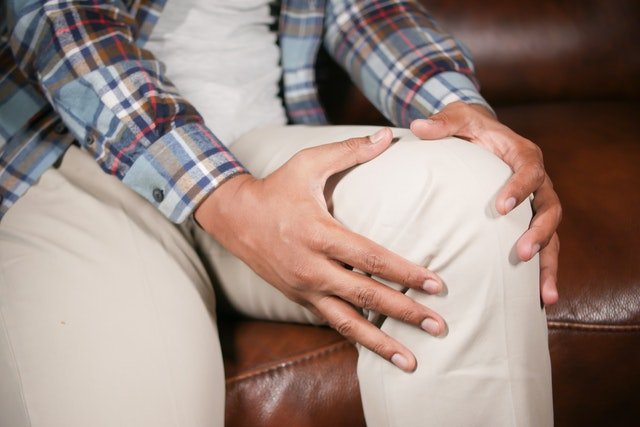
Osteoarthritis and rheumatism cause severe joint pain and complaints in the musculoskeletal system. Homeopathic medicines can relieve pain, improve joint inflammation and support other treatments for rheumatism and osteoarthritis.
Various complaints that affect the support and musculoskeletal system are summarized under rheumatism. It is an autoimmune disease that attacks your own body. The consequences are inflammations affecting bones, connective tissue, muscles and joints.
What is the difference between arthrosis and rheumatism?
The most common form of rheumatism, rheumatic joint inflammation (rheumatoid arthritis), causes pain, swelling, redness and restricted mobility. It is estimated that around 800,000 people are currently ill. Small joints are particularly affected, and the symptoms usually occur on both sides of the body at the same time. Over time, the inflammation destroys the joints and limits their mobility.
Osteoarthritis is the most common joint disease in adults. Articular cartilage slowly degrades. As osteoarthritis progresses, adjacent structures such as bones, muscles, joint capsules and ligaments can be affected. A joint that has been altered by arthrosis causes pain and restricted mobility and function. This leads to severe limitations in everyday life and a significant loss of quality of life. Osteoarthritis of the knee joints (gonarthrosis), hip joints (coxarthrosis) and shoulder joints (omarthrosis) is particularly common.
How can homeopathy help with arthrosis and rheumatism?
Accompanying homeopathic treatment of joint pain can be carried out for both acute and chronic symptoms. In particular, the relief of pain and slowing down the progression of the disease are goals of homeopathic therapy. It is used as a complement to other treatments for rheumatism and arthrosis. In this way, the amounts of painkillers and anti-inflammatory drugs can sometimes be reduced.
Homeopathic single and complex remedies are used for rheumatism and arthrosis. These are used as tablets, globules, drops, ointments or injections. Treatment should be carried out by a homeopath after a detailed medical history. Homeopathic self-treatment is particularly suitable if the symptoms in the area of the musculoskeletal system are to be significantly alleviated.
Homeopathic remedies for the treatment of joint problems
The following homeopathic individual remedies have proven themselves in the treatment of joint problems such as rheumatism and arthrosis:
Apis mellifica
- Apis mainly acts on the synovial membrane
- with stabbing pain
- Rapid onset of joint inflammation with edema and joint effusion
Arnica
- Pain as if sore and bruised
- numbness
- swelling of the affected joint
belladonna
- swollen, red, hot and shiny joints
- very sensitive to touch or the slightest shock
Bryonia
- acute swelling and feeling of tension
- sharp pains
- especially when the synovial membrane is involved
Cimicifuga
- cramping pain or pain that shoots up like electric shocks
- Restlessness and jerking of the limbs
Colchicum
- severe joint pain
- Periosteum and synovium affected
- Redness, heat and swelling of the affected joints
Dulcamara : for stiff neck and back pain
Ferrum phosphoricum
- when symptoms are developing
- acute, drawing pains
- Joints swollen but not red or swollen and very tender
ledum
- Ailments start in the feet and move upwards
- Joints sensitive to slightest vibration
Lycopodium
- Weakness and bruises in the extremities
- burning pains between the shoulder blades
- Cramps in calves and toes
Phytolacca
- Complaints drag on
- unbearable pain
Pulsatilla
- Pain moves from one place to another, the intensity of the symptoms changes very often
- Redness and swelling of the joints
- drawing, tearing pains
Rhus toxicodendron
- drawing, tearing pains
- particularly large joints affected
Silicea
- for hip and knee pain: pronounced weakness of the legs with the slightest exertion
- squeezing, shooting and lancinating pains
- pain in the knees
- Leg cramps when sitting
sulfur
- tearing pains in muscles and joints
- drawing pains from above downwards
- swelling of the joints
Complex remedy for rheumatism and arthrosis
Homeopathic complex remedies are also suitable for the treatment of joint pain. They combine various active ingredients against rheumatism and arthrosis complaints. They are offered as tablets, drops, ointments or as a solution for poultices.
How are homeopathic medicines taken?
Homeopathic single remedies are used in acute cases in potencies 6X and 12X. The most common are globules, drops and tablets. A dose consists of three globules, three drops or one tablet that melt under the tongue. This dose can be taken hourly in acute cases. However, a drug in the potency D6 should not be used more than ten times a day, and the potency D12 no more than six times a day. Repeat the intake until the symptoms improve significantly.
Rheumatism and arthrosis: What else can you do?
There are a few simple tips for people who suffer from rheumatism or arthrosis. In this way, they can help to live better with their illness and, if possible, avoid or delay surgical treatment.
The Deutsche Rheumaliga recommends a simple principle: live healthy! This can be transferred to osteoarthritis. In addition to an appropriate body weight, regular exercise is considered particularly important. Special rheumatism or arthrosis gymnastics, functional training and physiotherapy should help to strengthen muscles and keep the joints flexible. Low-impact sports like swimming and cycling can also be helpful.
Diet can also contribute to joint problems improving or at least not getting worse. A “joint-friendly” diet should be low in purine and arachidonic acid, since both substances are involved in the development of inflammatory processes in the body. Fatty sausage, offal, lard, egg yolk, certain types of fish such as sardines, herring, tuna and trout should disappear from the menu or be significantly reduced. Alcohol should also be avoided. However, the consumption of dairy products, nuts, fruit, vegetables and potatoes is recommended.






